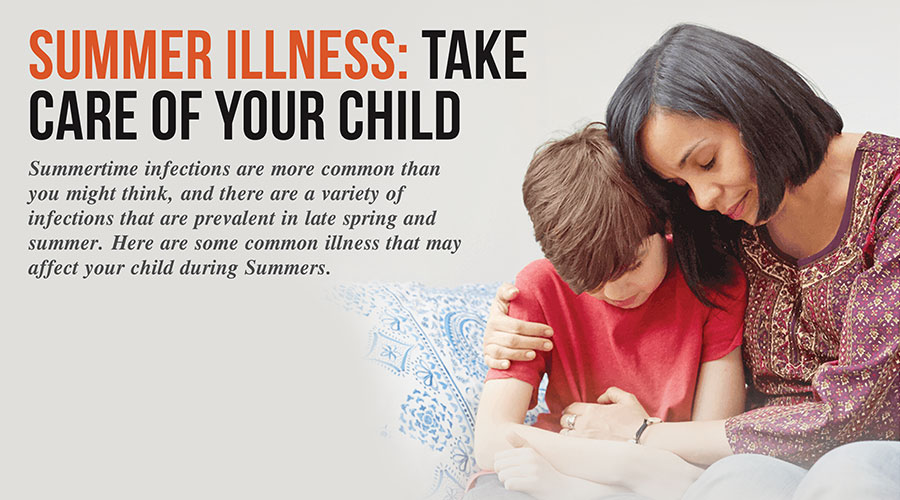9 ACTIVITIES TO IMPROVE YOUR TODDLER'S DEVELOPMENT
- 20 Apr - 26 Apr, 2024
Summertime infections are more common than you might think, and there are a variety of infections that are prevalent in late spring and summer. Here are some common illness that may affect your child during Summers.

Vector-borne diseases are caused by viruses, bacteria, and parasites that are spread by ticks, mosquitoes, tsetse flies, mites, snails, sand flies, triatomine bugs, black flies, and lice. Around 17% of all infectious diseases are vector-borne diseases. Every year there are more than 700,000 deaths globally from diseases such as yellow fever, Japanese encephalitis (JE), dengue fever, schistosomiasis, leishmaniasis, trypanosomiasis, chagas disease, onchocerciasis, and malaria. Mosquitoes are the best-known disease vector. The vectors usually swallow the pathogen while sucking blood from an infected host. During their later blood meal, the infected insects transmit the pathogen to a new host through bite. Some vectors of different diseases that are significant to public health are mosquitoes, ticks, fleas, flies, and sand flies The main VBDs in Pakistan are malaria, dengue, chikungunya, leishmaniasis, and West Nile fever.
Mosquito and tick-borne infections can be avoided by keeping your child away from ticks and mosquitoes. If you live in a high-risk area for Lyme disease, make sure your child wears long-sleeved shirts and long pants, as well as high socks and boots. You can also use tick repellent and tuck your child's pant legs into his socks. Check your child's body for ticks at least once or twice a day, more frequently if you've been camping or playing in tick-infested areas (grassy, brushy, or wooded areas).
Mosquito bites can be avoided by using an insect repellent containing DEET, citronella, or soybean oil. Wear light-colored clothing and avoid using scented soaps or other products that may attract insects. Avoid areas where there are insect nests. Citronella and soybean oil can help to keep mosquitoes at bay.
Food poisoning or food-borne illnesses are another common cause of infection and illness during the summer months. Because bacteria thrive in warm, moist environments, food poisoning is more common in the summer, when there are more cookouts and picnics. Food poisoning can be avoided by frequently washing your hands and cooking surfaces, avoiding cross-contamination of foods and utensils, cooking foods to the proper temperature, and promptly refrigerating leftovers.
Naegleria fowleri can cause amebic meningoencephalitis, a rapid and usually fatal infection. It affects children who swim in warm, polluted, and stagnant water, such as a lake or poorly chlorinated swimming pool.
Polio, caused by an enterovirus, is the most well-known illness caused by a summer virus. Because of the poliovirus, parents frequently refused to let their children play outside in the 1940s and 1950s. 5 Infected children would experience a mild sore throat and fever, followed by meningitis and/or paralysis within a few days. Thankfully, thanks to routine immunisations, polio is on its way out in most parts of the world.
There are other enteroviruses which can cause illnesses, such as group A and B coxsackieviruses, echoviruses, and enteroviruses. These viruses usually cause mild respiratory symptoms (cough and runny nose) and gastrointestinal symptoms (diarrhea and vomiting), but they can also cause more severe infections, such as aseptic meningitis, encephalitis, and myocarditis.
Other common childhood illnesses that are caused by nonpolio enteroviruses include hand, foot, and mouth disease (HFM), caused by the Coxsackie A16 and Enterovirus 71 viruses. Children with HFM can have blisters or ulcers in the mouth and on their hands and feet. Or, they can have ulcers just in their mouth, which is called herpangina.
Another common summertime virus is parainfluenza virus 3. This virus can cause croup, bronchiolitis, pneumonia, or just a cold. The characteristic barking cough of croup, which is often described as sounding like a seal, makes this virus easy to identify in the summertime. Overall, though, croup is more common in the winter. Adenoviral infections are also more common in the winter, but they can also occur in the early summer. Symptoms can include fever, sore throat, and other upper respiratory tract infections. Adenovirus can also cause pharyngoconjunctival fever, with a sore throat, fever and red eyes without discharge or matting.
Many infections are spread from fecal-oral and respiratory routes from other infected children. Simple hand washing and avoiding sharing food or drinks with other children, especially sick children, can help greatly reduce your child's chances of getting sick too. Being extra careful at summer camp, where children are exposed to a lot of other people, can also help to reduce infections.
COMMENTS